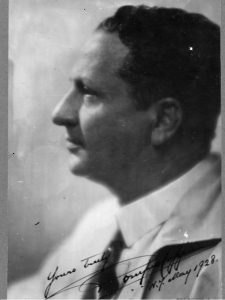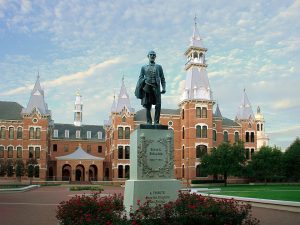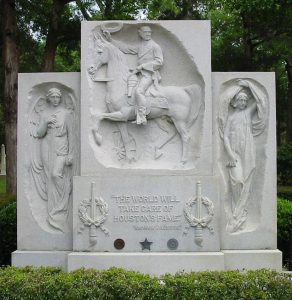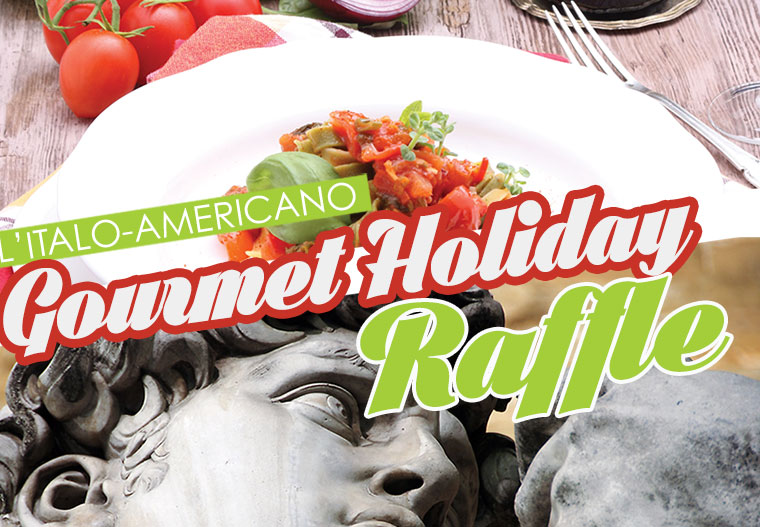Pompeo Luigi Coppini. The name itself conjures up images of greatness, eminence, and well, someone who must be pretty important, yes?
Fortunate enough for the bearer, his was an illustrious life, this Lombard-turned-Texan sculptor. But like those flitting grains of sand in the hourglass of time, the name has, for all purposes, slipped into obscurity save for works that bear his chiseled signature.
Much like his many creations, Pompeo Coppini was a man larger than life. Pompous, egotistical, stubborn – qualities that often befit the creative type – yet any argument against his extraordinary talents and legacy quickly shift to the floor like so much marble dust. And most likely, all his self-aggrandizing was just a bit more glue bonding Pompeo tightly to the bosom of his adoptive home of Texas where, after all, vainglory with substance can be quite a celebrated trait.

The year 1870 brought forth a son to Giovanni and Leandra Coppini, a struggling young couple in the small town of Moglia, just southeast of Milan. A man born/cursed with the need to create, Giovanni found his wealthy roots about dried up by the time he was of age, thus necessitating a move to Florence shortly after Pompeo’s birth for work with the railroad.
It was pretty clear, however, that this son had come into the world “sprinkled with pixie dust”, as writer Stephen Harrigan so aptly puts it (Texas Monthly, Oct. 1986), and was on a path to “follow the steep heights to glory” (From Dawn to Sunset, P. Coppini). Understandably, this didn’t go over too well with Papa Coppini who undoubtedly was pushing his son towards a reasonable bread winning occupation as a civil engineer with the railroad.
Like many young genius types, Pompeo was less than compliant with expected norms and managed to get himself kicked out of virtually every school in which he attempted to warm the seat of a bench. Sullen and misunderstood, he found solace — and the beginnings of his life calling — when he garnered work at age 10 crafting whimsical whistles within the dimly lit rooms of an artisan shop in Florence. Step one lead to step two, and Pompeo found work in the studio of a sculptor situated beneath the family apartment carving knock-offs of Michelangelo, Bonucelli, and other famed sculptors, fodder for souvenir-hungry tourists. Finding meaning in these creative outlets poured heady fuel on Coppini’s burning desire to create.
By age 16, the young Coppini wearied of wearing the millstone of an unhappy home and layered school failures; he helped himself to his father’s nest egg and embarked towards an unknown future. Fortunately for us, his talents were at last acknowledged and given a chance to ripen when his forgiving father acquiesced, finding him accommodations in the Accademia di Belle Arti under the tutelage of Augusto Rivalta. Completing the eight-year course at mercurial speed, Copponi stepped into the real world after only three years of study – clutching a diploma embossed with “highest honors”.

Coppini immediately set up shop, shrewdly offering busts of the rich and famous – at no charge. His busy savvy manifested early; Coppini knew that this echelon of society would be the one he would depend upon for artistic commissions, his modern Medicis, and conjoined with his lightning-fast ability to knock out a bust, it seemed a fine coupling.
The studio, however, didn’t succeed as planned, and after yet another failed business attempt and a love affair gone bad, the master drew the conclusion that America just might offer a friendlier welcome. With a trunk of “very good clothes”, a bit of change in his pocket, and an only slightly bruised ego, he set sail for New York City.
Fate smiled upon Coppini – he set foot on American soil in 1896, right in the big middle of the artistic age known as “Moral Earnestness” — an era of big, bold, heroic, and, dare we say, pretentious sculpture that portrayed a moral realism…when in check. However, human nature generally goes into overdrive with any good thing, and the result here equated to Herculean musculature rippling into overtime and virtuous maidens pushing every symbol of truth and light into the heavens…and faces of the beholder. Coppini was in his element.
As competent as he might’ve been, however, New York was not as indulgent to Coppini as he’d bet on. Multiple attempts at commissions typically went to the established clan of American artists; Coppini found himself subjugated to lowly assistant. In his less-than- humble opinion, the whole lot was not much more than a cartel bulging with jealous peers holding him back, giving “undue power to a very few unscrupulous art racketeers.”
Whether this was truth or altered perception, his hound-dog like sense of sniffing out patrons held strong, allowing for steady, if not glamorous, employment. One such commission, however, did come with a bit of a perk. While modeling for the figure of Columbia in a memorial to Francis Scott Key, the nubile and suitably chaperoned Miss Elizabeth Di Barbieri quickly conquered the heart of Pompeo with her “beautiful, queenly countenance”. “I do’s” were said not long after.
With any worthwhile tale, about the time the plot is sure to end in woe –- enter the resurrecting protagonist. And for Coppini, who was ready to wrap up the chisels and head home to Italia with his bride, it came in the form of a call from Texas. The search was on for a sculptor willing to take on a nine-foot statue of Confederate war hero Jefferson Davis for part of a memorial on the State Capitol grounds. The man from Moglia decided to take a chance.
Arriving in San Antonio by train, Coppini immediately plunged himself into work at a fervored pace. A mere nine days later and the plaster cast was ready for pouring. A flabbergasted committee marveled at the prototype that would’ve taken the average-Joe artist some six months to complete, and immediately tossed aside four already completed statues for the same memorial, reassigning them to Coppini.

“I was reborn a Texan” … “I became more and more popular every day”, the far-from-shrinking violet wrote. San Antonio offered up that Land of Milk and Honey that Coppini had sought, proffering both a city that was wide open for commissions and a populace ripe for embracing a wavy-haired, be-smocked Italian sculptor whose talents equaled his ego. Employment was steady and each commission was reported on excitedly by the local newspapers; his involvement in the community was immediate in matters civic and social – Pompeo Coppini – Sculptor was now a Texas celebrity.
A state competition was held in 1905 seeking an artist to sculpt an equestrian statue to honor Terry’s Texas Rangers, a renown Civil War regiment. Coppini faced stiff competition amongst seventeen esteemed and well-established artists, including the queen of Texas sculptors, Elisabet Ney, whose reputation guaranteed – so she thought – the commission. Upon learning that she had been dethroned by an Italian newcomer, her dismay was not subtle. She wrote in the Austin Statesman, “Alas! It seems the mere word Italian stands by most people here in Texas for greatness in art. It is a great pity that Texas can again be duped.” With unaccustomed calm, Coppini’s retort was “I paid not much attention to her ‘meow’, for after all I realized that it must have worried her to get someone else in her field, especially an aggressive, ambitious young man, who had given proof of real ability.”
This heralded work stands guard today on the grounds of the State Capital, the talented Ms. Ney’s disdain a long-forgotten fury.
As Coppini’s popularity grew, his bank account kept equal pace. He began construction on his Madeleine Terrace mansion in the upscale Alamo Heights area of San Antonio. Sparing no expense, the artist included a specialized concrete vault that could store two tons of clay; a monstrous studio equipped with rolling cranes capable of lifting a ton each of artistic mass; and 35 foot ceilings towering overhead to accommodate his works in progress. His home befitted this celebrated master, the Texan Reborn.
Part two of Pompeo Coppini’s story will be published in the edition of January 26.
































